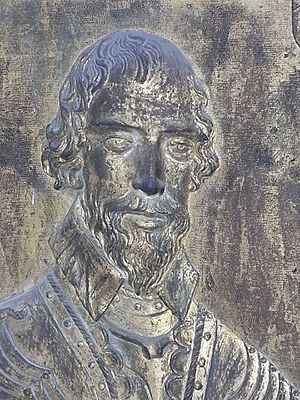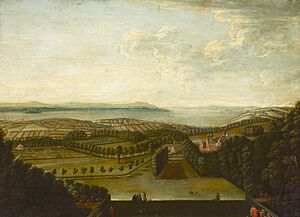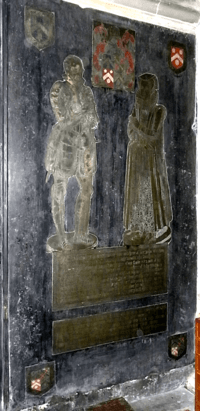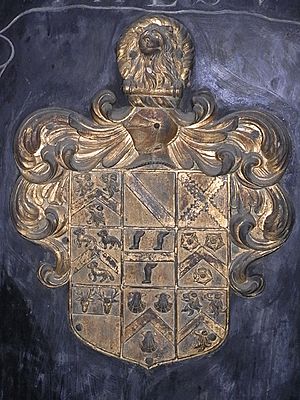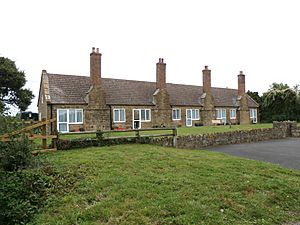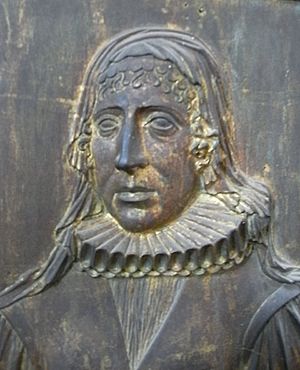John Wyndham (1558–1645) facts for kids
Sir John Wyndham (born in 1558, died on April 1, 1645) was an important English landowner from Orchard Wyndham in Somerset. He was also a Justice of the Peace, which meant he helped keep law and order. Sir John played a big part in setting up defenses in the West Country of England to protect against a possible invasion from Spain.
Contents
Sir John Wyndham's Family History
Sir John Wyndham was born at Orchard Wyndham. He was the only child of Sir John Wyndham (who died in 1572) and Florence Wadham (1538–1597). His mother, Florence, was a co-heiress of her famous brother, Nicholas Wadham. Nicholas Wadham and his wife, Dorothy Petre, were very important because they founded Wadham College, Oxford, a well-known university college.
Sir John Wyndham helped his uncle Nicholas Wadham make his dream of founding Wadham College come true. To honor his parents, Sir John had special brass memorials made for them in St Decuman's Church in Watchet. He also had similar, beautiful brasses made for his uncle Nicholas Wadham and his wife in the Church of St Mary, Ilminster. These memorials are considered some of the best of their kind in England.
Family Coat of Arms
Sir John Wyndham's family history is shown through his heraldic achievement, or coat of arms, on his monument in Watchet Church. This special design includes a crest, which is a lion's head, and several "quarters" or sections. Each quarter shows the coat of arms of a different important family that married into the Wyndham family over time. For example, the first and ninth quarters show the Wyndham family's own arms: Azure, a chevron between three lion's heads erased or. Other sections show the arms of families like Scrope, Tiptoft, Sydenham, Gambon, Wadham, Popham, and Pollard, all connected to Sir John's ancestors.
Sir John's Birth and Early Life
Sir John Wyndham is an ancestor to many people in the widespread Wyndham family today. His birth is linked to a very famous story about his mother, Florence. The story says that about a year after she got married, Florence became very ill and was thought to have died. She was placed in a coffin in the Wyndham Chapel at St Decuman's Church, waiting for her funeral the next day.
That night, a greedy sexton (a church worker) secretly entered the church. He tried to take a valuable ring from Florence's finger. As he cut her finger, she woke up from what was actually a deep trance! The sexton ran away, leaving his lantern. Florence used the lantern to find her way home, surprising her family. Soon after, she gave birth to Sir John, her only child. This amazing story was even written as a poem called "Lady Wyndham's Return."
When Sir John's father died, Sir John was only twelve. Because his family held land directly from the Queen, Queen Elizabeth I had the right to decide who would take care of him and whom he would marry. However, his grandfather was able to buy back this right, which meant Sir John could not be forced into a marriage he didn't want.
Protecting England from Spain
Sir John Wyndham played a key role in organizing defenses in Somerset county. This was very important because England faced a big threat of invasion from Spain. The number of trained foot soldiers in Somerset doubled in just twenty years, showing how much the defense efforts grew. Even though the Spanish Armada was defeated and England was saved from invasion, the defense movement was vital. It helped prepare the country and made people realize how important it was to protect their home.
Working as a Justice of the Peace
As a Justice of the Peace, Sir John was one of the county judges. This meant he was responsible for local government and administration. He acted as the central government's representative and helped manage local affairs, as well as attending court sessions.
Role in the Civil War
When the English Civil War began, Sir John seemed to support the Parliament's side. This was shown when his cousin, Sir Francis Wyndham, who supported the King, attacked Orchard Wyndham in June 1644. They took about £4,000 worth of goods for the Royalist cause. Three months after this event, Sir John gave £4,000 each to his eighth and ninth sons, Sir Hugh Wyndham and Sir Wadham Wyndham, for safekeeping.
Helping to Found Wadham College
While Nicholas Wadham's wife, Dorothy, was mainly in charge of setting up and building Wadham College, Oxford, Sir John Wyndham also played a part. He was with his uncle Nicholas Wadham just before he died in 1609. Sir John kept a detailed record of a conversation he had with his uncle four days before his death. In this talk, Nicholas Wadham spoke about his great desire to build a college in Oxford and trusted Sir John to make sure everything was done according to his wishes.
Felbrigg Hall Inheritance
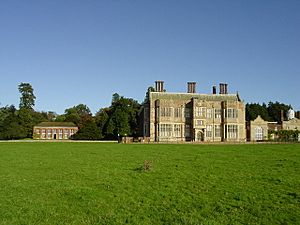
In 1599, Sir John inherited the Felbrigg estate in Norfolk, which included Felbrigg Hall. He received it from his father's cousin, Thomas Wyndham, who had no children. Felbrigg was the main home of the older branch of the Wyndham family. To show his thanks, Sir John placed a special brass memorial in Felbrigg Church for Thomas Wyndham and also for Thomas's sister, Jane Wyndham.
Sir John gave Felbrigg Hall to his third son, Thomas Wyndham (who died in 1653). He helped Thomas rebuild the old manor house, which was finished in 1624 and still stands today. The coats of arms of Sir John and his son can still be seen carved in stone above the front door.
Wadham Family Inheritance
Sir John inherited some land from his uncle Nicholas Wadham, as his mother was one of Nicholas's sisters and co-heiresses. Among the estates he received was Ilton in Somerset. There, he tore down the old Wadham family home, Merryfield. It's believed he used the materials from Merryfield to build a farmhouse and also some almshouses (homes for poor people) in the village of Ilton.
He also inherited Silverton in Devon, and Wadham in Devon, which was the very first home of the Wadham family.
Marriage and Children
Sir John Wyndham married Joan Portman. She was the daughter of Sir Henry Portman from Orchard Portman, Somerset. Sir John and Joan had a large family with nine sons and six daughters:
Sons
- Henry Wyndham (1583–1613), the oldest son, who studied law but died before his father.
- John Wyndham (died 1649), the second son.
- Thomas Wyndham (died 1653), the third son, who received Felbrigg Hall from his father.
- Humphrey, possibly the sixth son.
- George Wyndham of Uffords Manor, Cromer, Norfolk.
- George Wyndham ("senior"), (1592–1624), a soldier.
- Hugh Wyndham, the eighth son, who became a judge.
- Sir Wadham Wyndham, the ninth son, who also became a judge.
Daughters
- Joan Wyndham, who married Colonel John Giffard.
- Margaret Wyndham, who married John Courtenay.
- Florence Wyndham, who married John Harris.
- Rachel Wyndham, who married Thomas Moore.
- Margery Wyndham, who married Thomas Carew of Crowcombe Court.
- Anne Wyndham (died 1645), who married Sir John Strode.
Death and Memorial
Sir John Wyndham passed away on April 1, 1645. He was buried in Watchet Church in Somerset. There is a special memorial there for him and his wife, Joan Portman. It's a large stone slab placed against the wall, with beautiful bronze plaques showing their portraits and family coats of arms.
See also
- Wyndham baronets
- Earl of Egremont


